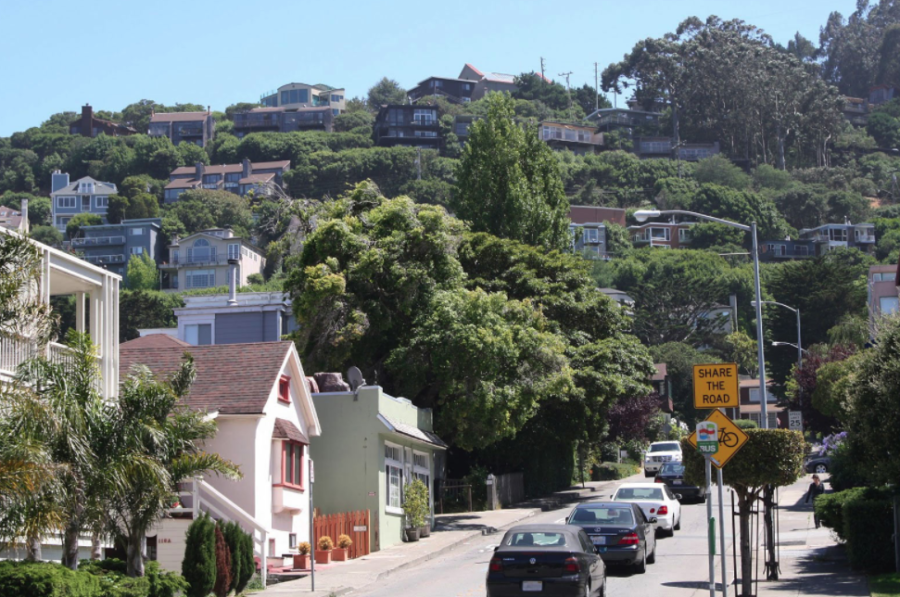COVID-19 Leads to Bay Area Housing Crisis
Houses in the Bay Area, like the ones in San Francisco, have experienced a stark rise in prices due to the Covid pandemic.
October 12, 2021
In the past year, COVID-19 has exacerbated the Bay Area housing crisis as competition has drastically increased housing prices.
“Median prices for single family homes across nine counties rose to $1.34 million in May, up from $965,0000 in May 2020 — a 38.9 percent increase year over year,” data released by the California Association of Realtors states. To put this in perspective, the median home price in the United States is $347,000. The median home price in the Bay Area skyrocketed from $965,000 to $1.34 million in the past year, due to a variety of reasons.
A major contributing factor to the increase in housing prices is that people have more money. “Since people have more money, from stocks, they’re willing to spend more money on buying a house.” explains Coldwell Real Estate Agent Rajul Shah.
COVID-19 has posed a hindrance to most working sectors, however, the technology sector used this time to their advantage and have been thriving.
Shah states, “Right now the economy is doing very well, so everyone’s stock prices have gone up. They have this liquid cash that they just got from stocks without doing anything.”
This, coupled with many smaller companies going public, which means that early employees are getting large amounts of stocks, has brought a lot of wealth to people working in the tech sector. This is especially prevalent in the Silicon Valley.
As tech becomes a booming work-from-home sector, people no longer have to live in cities, causing an influx to suburban areas. The COVID-19 pandemic forced companies to shift to a fully work-from-home model, leading to major changes in how work is carried out.
As living near the office is no longer a priority, Dougherty Valley AP Economics Teacher Daniel Farmer says, “In the bay area a big change because of the pandemic is people working remotely, so being further away from office buildings isn’t as big of a deal. Also, there’s a big exodus from San Francisco, specifically, as those houses have gone up and up in price, now people are seeing the value of being in a suburban pocket.”
Therefore people’s needs have changed, they are looking for houses with office space and more space for a meaning more people are looking for bigger houses and places to settle down, at levels much higher than before.
With this increase in people looking for houses in the suburbs, competition has increased while the number of houses are falling short. Right now there are a lot more buyers than sellers on the market. With an increase in people looking for houses and less houses for people to buy, competition for houses increases. This drives up house prices.
Farmer explains, “A house right now might go for sale, within four days, and sometimes there’s no open house, they’ll buy it without even looking at it. It is so competitive, even if sellers underprice their house, the price will be driven up.”
Shah further quantifies, “Any house that’s being listed for 1.8 is being sold for 2.3, so literally 500K or 400K over-asking.”
People with money will pay whatever necessary to get the homes they want. In May, a house in Berkeley was sold for 1 million dollars over asking-price.
Real estate agents know this is happening and many times purposely under-value homes in order to drive up bids on the house.
Shah speaks on this and says, “Since open houses have opened since June 15th, everyone is taking advantage of more crowds. More crowd in your house means pressure for the buyers because this house is a hot home and is going to go over asking by 200 or 300K. That’s why they are keeping a low price on purpose- more foot traffic, which is the goal in order to put pressure on the buyers.”
People with smaller budgets are recommended these houses that are purposely undervalued by the real estate agent, getting more people interested and increasing urgency.
Now people, even those with a smaller budget, can afford a lot more than before due to extremely low interest rates.
Interest rates, as Shah says, “are super low. Nobody has seen interest rates at 2.0% or 2.5%.” This is important because, “having a low interest rate gives you a bigger value to buy your home.” It also makes it easier to afford a home because, “you can get your pre-approval for more, if it was 1 million before it will now be 1.4 million, and the mortgage, at the end of the day, is exactly the same.”
With the COVID-19 pandemic impacting everyone’s daily lives, the consequences of that have been a variety of factors that have come together at the perfect time to create a seller-friendly market.
The Bay Area is notorious for its high housing costs and competition, which was only magnified during this housing crisis. Many people, especially those with a lower pay or those that fall under the poor-middle class bracket, are finding it harder than before to find a place to live.
Looking to the future, as the tech sector continues to grow, companies are opening offices in other cities. As people leave the Bay Area to follow these new opportunities, they are taking the high prices with them.
As the Bay Area and its residents get past the high housing prices, we are yet to see whether these prices will come down to normalcy after the COVID-19 pandemic lessens.



